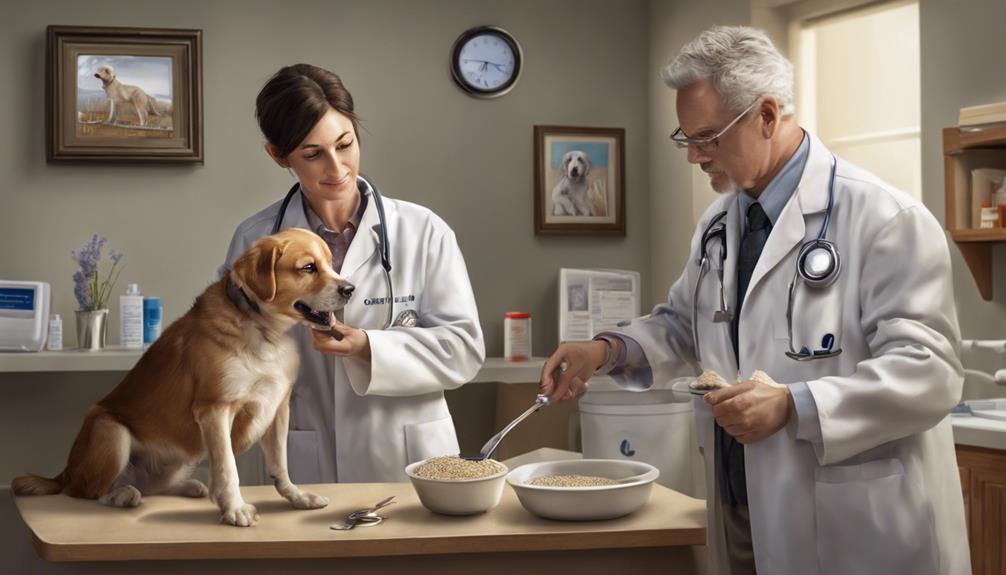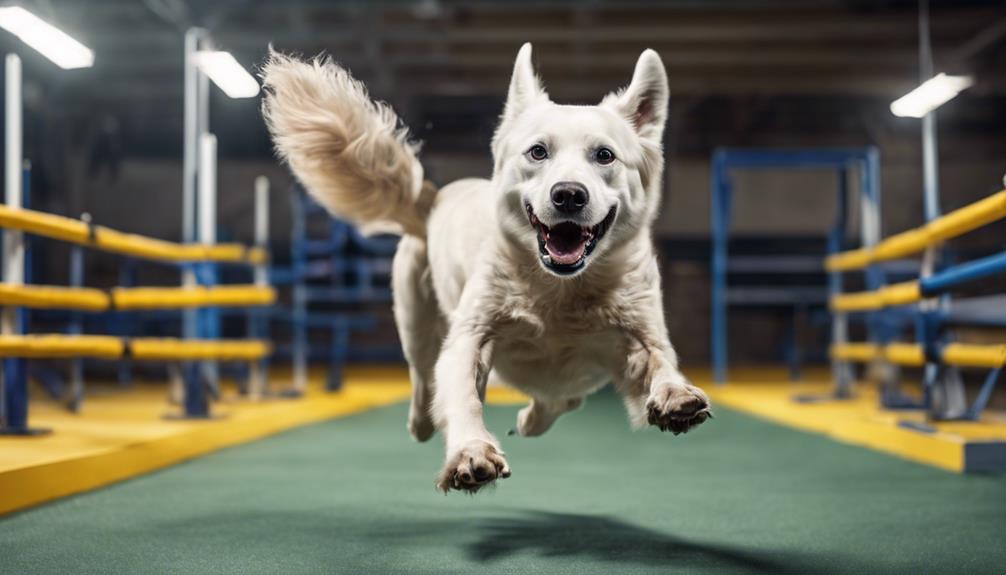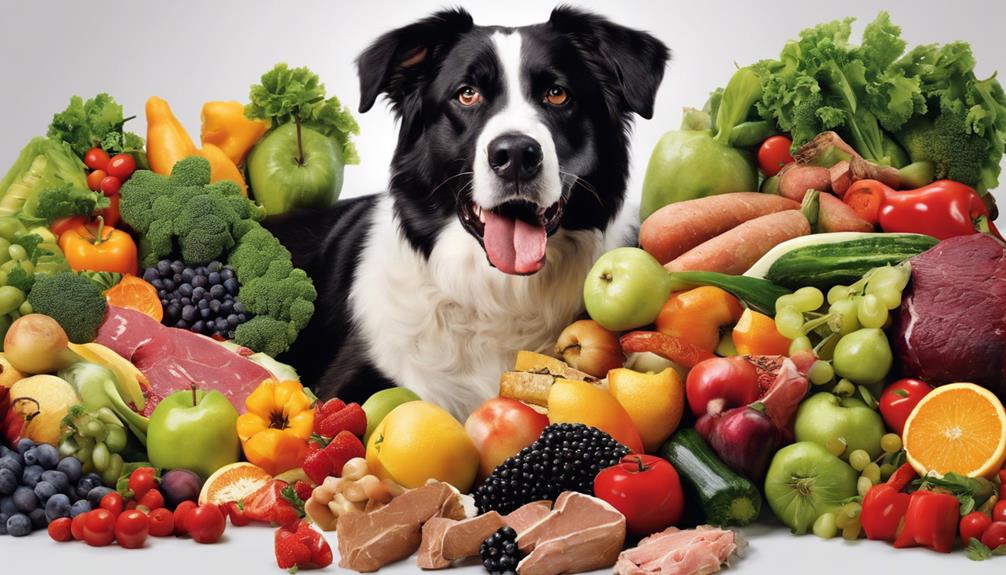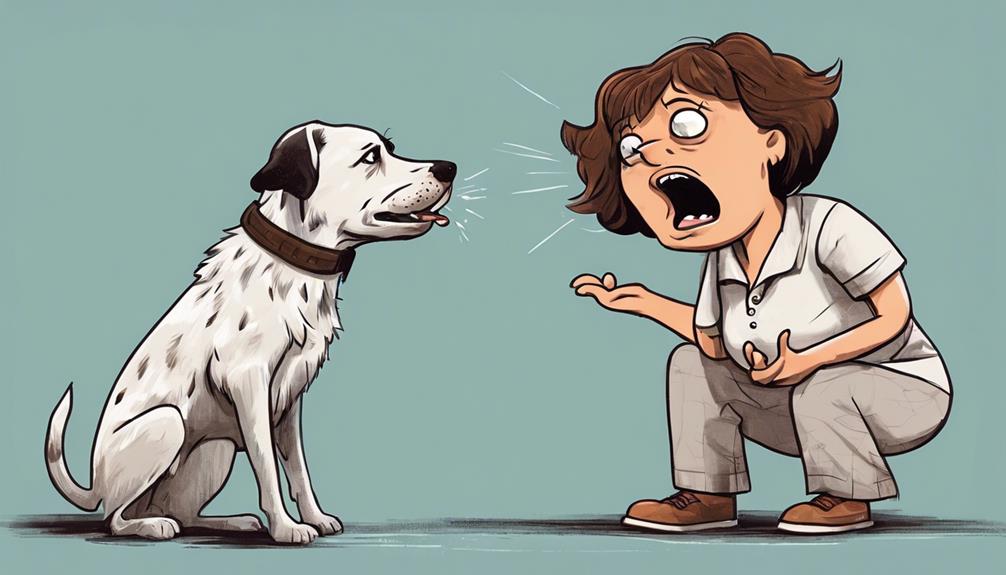Dogs
Can Dogs Have Oatmeal?

Yes, dogs can have oatmeal. It offers benefits like aiding digestion and promoting weight management. However, caution is essential. Avoid harmful ingredients like raisins, grapes, and chocolate. Stick to plain, cooked oatmeal with water. Skip the salt, butter, or sugar. Start with small portions to complement regular meals. Check serving sizes based on your dog's weight. Moderation is key. If you want to learn more about how to incorporate oatmeal into your dog's diet for maximum health benefits, keep exploring the valuable insights provided.
Key Takeaways
- Oatmeal is safe for dogs in moderation.
- Plain, cooked oatmeal with water is best.
- Avoid harmful additives like raisins, chocolate, and sugar.
- Monitor portion sizes to prevent digestive issues.
- Consult a vet for personalized dietary advice.
Nutritional Benefits of Oatmeal for Dogs
Oatmeal provides essential nutrients, such as soluble fiber, vitamins, and minerals, that are beneficial for a dog's overall health. Dogs can benefit from these nutrients in various ways. The soluble fiber in oatmeal supports digestion, weight management, and helps regulate their digestive system. This fiber also plays a role in promoting a feeling of fullness, which can prevent overeating and aid in weight control. Additionally, the vitamins and minerals in oatmeal, like iron, zinc, and B vitamins, contribute to the health of a dog's coat and skin.
When considering feeding oatmeal to dogs, it's important to select plain oatmeal without any added ingredients like sugar or raisins. Consulting a veterinarian before introducing oatmeal into your dog's diet is advisable to validate it aligns with their specific nutritional needs. By incorporating oatmeal into your dog's diet in a safe and controlled manner, you can provide them with a nutritious addition that supports their overall health and well-being.
Risks of Feeding Oatmeal to Dogs

With a focus on the potential dangers associated with feeding oatmeal to dogs, it's important to be mindful of toxic ingredients and non-toxic additives that can adversely affect their health. Toxic ingredients like raisins, grapes, chocolate, and nutmeg can be harmful to dogs if present in oatmeal. Additionally, non-toxic additives in flavored oatmeal can lead to obesity and upset stomach in dogs.
Excessive fiber from oatmeal can cause stool issues and digestive problems in dogs. Balancing fiber intake is essential for best digestion and overall health in dogs. It's vital to pay attention to harmful toppings and portion sizes when feeding oatmeal to dogs. Ensuring that the oatmeal is free from harmful ingredients and additives will help maintain your dog's well-being.
Remember to provide fresh water alongside oatmeal to aid digestion and prevent dehydration. By being cautious about the food choices you make for your dog, you can help them stay healthy and happy.
Safe Preparation of Oatmeal for Dogs

When preparing oatmeal for dogs, it's important to use water instead of milk to prevent potential digestive issues. Dogs eat oatmeal, but it should be plain, well-cooked, and cooled before serving. Avoid adding salt, butter, chocolate, raisins, grapes, sugar, or artificial sweeteners.
Start with small amounts of oatmeal as a complement to your dog's regular food. Monitor their response to make sure they tolerate it well. Always opt for safe preparation methods to keep your furry friend healthy and happy.
Recommended Oatmeal Serving Sizes for Dogs

When providing oatmeal to dogs, it's important to take into account their weight – typically, dogs can have 1 teaspoon to 1 tablespoon of oatmeal per 20 pounds they weigh. To maintain a healthy diet, limit oatmeal treats to just a few times per week, ensuring they don't exceed 10% of the daily calorie intake.
Overfeeding oatmeal may cause digestive issues like bloating, flatulence, or diarrhea, so it's vital to consult a vet for specific dietary guidance.
Proper Oatmeal Portion
For dogs, it's important to carefully measure the oatmeal portion based on their weight to ensure proper consumption. Make sure to feed your dog 1 teaspoon to 1 tablespoon of oatmeal per 20 pounds of their weight.
Oatmeal can be a beneficial breakfast addition to your dog's diet, but remember that treats shouldn't exceed 10% of their daily calorie intake to prevent weight gain. Limit oatmeal treats to a couple of times per week to maintain a balanced diet.
Avoid using oatmeal with added ingredients like sugar or artificial flavors, as these can be harmful to your dog's health. If you're unsure about how much oatmeal to give your dog, consult your veterinarian for guidance.
Oatmeal for Dogs Diet
Dogs should be given oatmeal in carefully measured portions according to their weight to maintain a healthy diet. When feeding your dog oatmeal, keep in mind that moderation is key. Too much oatmeal can lead to digestive issues. Consider giving your dog water instead of milk with oatmeal, as some dogs may be lactose intolerant. Here is a recommended serving guide based on weight:
| Dog Weight (lbs) | Oatmeal Serving (tsp – tbsp) |
|---|---|
| 10 | 0.5 – 1 |
| 20 | 1 – 2 |
| 30 | 1.5 – 3 |
| 40 | 2 – 4 |
Incorporating Oatmeal in Your Dogs Diet

To incorporate oatmeal into your dog's diet, consider preparing it plain and cooked with water to guarantee maximum nutritional benefits without added sugars or flavors. Raw oatmeal should be cooked to make it easier for your dog to digest.
Oatmeal is a great source of soluble fiber, vitamin B, and linoleic acid, all essential for your dog's health. Remember, moderation is key – aim for 1 teaspoon to 1 tablespoon per 20 pounds of your dog's weight.
It's important to avoid flavored or sweetened oatmeal varieties, as they may contain ingredients harmful to your furry friend. Make sure the oatmeal is cooled down before serving to prevent any mouth burns.
Additionally, oatmeal should complement a well-balanced commercial dog food diet to ensure your pup receives all the necessary nutrients for peak health and digestion.
Can Dogs Eat Oatmeal Cookies?

Oatmeal cookies may seem tempting, but they pose risks to our furry friends. Ingredients like raisins, chocolate, nutmeg, or xylitol can be harmful to dogs.
Stick to plain, cooked oatmeal to keep your pet safe and healthy.
Oatmeal Cookies Safety
While oatmeal can be a healthy option for dogs, oatmeal cookies should be avoided due to potential harmful ingredients like raisins, chocolate, nutmeg, or xylitol. When it comes to our furry friends, it's crucial to prioritize their well-being by steering clear of foods that could pose risks.
Here are three important points to keep in mind regarding oatmeal cookies for dogs:
- Oatmeal cookies often contain high sugar levels, butter, and oil, which can lead to sickness in pets.
- Opting for plain, cooked oatmeal is a safe alternative to offering oatmeal cookies to your dog.
- Look for pet-safe oatmeal treats or other dog-friendly snacks to safeguard your furry companion's health and happiness. Remember, avoiding oatmeal cookies and sticking to plain, cooked oatmeal is the way to go for your pet's well-being.
Oatmeal Cookies Moderation
In moderation, dogs can enjoy oatmeal cookies as an occasional treat, but caution must be exercised due to potential health risks associated with certain ingredients. While oatmeal is high in fiber and a good source of nutrients for dogs, oatmeal cookies often contain ingredients like raisins, chocolate, nutmeg, or xylitol, which can be harmful to our furry friends.
Excessive levels of sugar, butter, and oil in these cookies can also lead to health issues in pets. It's wiser to opt for plain, cooked oatmeal instead of oatmeal cookies when treating your dog. Look for pet-safe oatmeal treats or other dog-friendly snacks as secure alternatives to make sure your canine companion stays healthy and happy.
Consulting a Veterinarian About Oatmeal

Before introducing oatmeal to your dog, it's important to consult a veterinarian for guidance tailored to their specific dietary needs. When you check with your veterinarian, they can give your dog personalized advice on incorporating oatmeal into their diet.
Here are three essential aspects to ponder:
- Amount: Your veterinarian can recommend the appropriate quantity of oatmeal to give your dog based on their size, age, and health status. This guidance is pivotal to prevent overfeeding and guarantee that your dog receives the right balance of nutrients.
- Allergies and Sensitivities: Veterinarians can help you identify if your dog has any allergies or sensitivities to oatmeal or specific ingredients it may contain. This information is crucial in avoiding any adverse reactions and keeping your dog healthy and comfortable.
- Dietary Benefits: Your veterinarian can explain how oatmeal can help support your dog's overall health, such as providing a good source of fiber or a type of omega-6 fatty acid. They can also advise on any necessary changes to your dog's diet to accommodate the addition of oatmeal effectively.
Consulting a veterinarian ensures that you steer clear of any potential risks and make informed decisions regarding your dog's nutrition.
Frequently Asked Questions
How Much Oatmeal Can You Give a Dog?
We can give a dog oatmeal in moderation. The amount should be around 1 tablespoon of cooked oatmeal for every 20 pounds of their weight.
It's important to limit oatmeal treats to a couple of times per week to prevent overfeeding issues. Treats shouldn't exceed 10% of a dog's daily calorie intake for a balanced diet.
Overfeeding oatmeal can lead to gastrointestinal problems like bloating and diarrhea. Consulting a vet for essential advice on your dog's diet is vital.
Can Dogs Eat Quaker Oats?
Yes, dogs can eat Quaker Oats as long as they're plain and cooked without any additives. It's important to avoid versions with added sugar, salt, or artificial sweeteners.
Quaker Oats can provide fiber and nutrients that are beneficial for dogs. Remember to let the oats cool down to room temperature before serving them to your furry friend.
Moderation is key when feeding Quaker Oats to dogs.
Is Oatmeal or Rice Better for Dogs?
Oatmeal is generally the better choice for dogs over rice due to its higher fiber content and nutrient profile. It contains essential vitamins and minerals like B vitamins and iron, aiding in digestion and weight management.
Its soluble fiber helps regulate blood glucose levels. When deciding between oatmeal or rice for dogs, oatmeal is often the more beneficial option for overall health and nutrition.
Can Dogs Eat Oatmeal and Peanut Butter?
Yes, dogs can eat oatmeal and peanut butter as long as it's in moderation. Peanut butter provides protein and healthy fats that complement the fiber in oatmeal. It's important to make sure the peanut butter doesn't contain xylitol, a dangerous ingredient for dogs.
Avoid varieties with added sugars or salt when feeding it to dogs with oatmeal. Always consult a vet before introducing new foods like oatmeal and peanut butter into your dog's diet.
Conclusion
To sum up, oatmeal can be a nourishing addition to your dog's diet when prepared and served properly.
While some may worry about the safety of feeding oatmeal to dogs, as long as you follow our guidelines, your furry friend can enjoy this tasty treat in moderation.
Remember to consult with your veterinarian before making any alterations to your dog's diet to guarantee their health and well-being.
Dana is our Lead Content Writer, bringing a wealth of knowledge and expertise to our team. With a background deeply rooted in animal studies and a profound love for all creatures, Dana is dedicated to crafting engaging and informative content that resonates with our audience. With Dana at the helm, you can trust that our content is accurate and engaging, catering to the diverse interests of animal enthusiasts everywhere.
Dogs
The Meaning of Tilly: A Dog Owners Guide
Navigate the intricate world of understanding Tilly's behavior and needs, unraveling the key to a deeper connection with your canine companion.

Understanding Tilly's behavior and needs is vital for enhancing your bond with your dog. Dogs communicate through body language, vocalizations, and facial expressions, offering insights into their emotions. Positive reinforcement and consistent training routines are essential for effective communication and behavior improvement. Playing, training, and exploring together fosters a strong bond. Social interactions, mental stimulation, regular exercise, and a balanced diet contribute to Tilly's emotional well-being and overall happiness. Observing body language cues, using positive reinforcement, and being critical in training are pivotal. Consult with professionals for any behavioral challenges your dog may face. Enhance your connection with Tilly by prioritizing her well-being.
Key Takeaways
- "Tilly" is a common name for female dogs.
- The name Tilly can mean "strength" or "battle-might."
- Tilly can also signify "mighty in battle" or "warrior."
- It is a cute and endearing name for a beloved pet.
- The name Tilly reflects attributes of courage and resilience.
Understanding Canine Behavior
Understanding canine behavior is crucial for fostering a strong bond between dog owners and their furry companions. Dogs communicate primarily through body language, vocalizations, and facial expressions, which provide valuable insights into their emotions and intentions.
By paying attention to behavioral cues such as tail wagging, ear position, and eye contact, we can better comprehend our canine friends' state of mind. When a dog wags its tail, for example, it can indicate excitement, happiness, or even nervousness depending on the context. Similarly, ear position and eye contact can express feelings of alertness, submission, or aggression.
Dogs also communicate through behaviors like barking, growling, licking, and wagging their tails, each serving as a form of expression in different situations. By interpreting and responding to these cues appropriately, we can strengthen the bond with our dogs and guarantee effective communication, fostering a harmonious relationship built on mutual understanding.
Effective Training Techniques

When training our furry companions, we find that positive reinforcement methods yield the best results.
Importance in our training routines is essential for our dogs to understand and respond to our cues effectively.
Keeping training sessions engaging and rewarding good behavior promptly are vital strategies in fostering successful training outcomes.
Positive Reinforcement Methods
Positive reinforcement methods for dog training involve utilizing rewards such as treats, praise, and toys to encourage desired behaviors. When implementing positive reinforcement with your furry companion, keep these key points in mind:
- Consistency: Providing rewards consistently for desired behaviors reinforces learning.
- Patience: Dogs may take time to understand what's expected of them, so tolerance is essential.
- Bonding: Using positive reinforcement helps strengthen the bond between you and your dog.
- Effectiveness: Scientifically proven to be more effective and humane than punishment-based methods.
Consistent Routine Training
Establishing a consistent routine is essential for effective dog training techniques. A structured training schedule not only helps our furry friends learn and retain commands better but also contributes to long-term behavior improvement. The key lies in repetition and consistency during training sessions.
By following a regular routine, we not only help our dogs understand what's expected of them but also strengthen the bond between us. Consistent training leads to positive results and well-behaved dogs.
Building a Strong Bond
Regularly engaging in activities that promote interaction, understanding, and trust is key to forging a strong bond with your dog. By spending quality time with your furry companion, you can create a deep connection that will last a lifetime. Here are some tips to help strengthen the bond with your pet:
- Play Together: Engage in fun activities like fetch, tug-of-war, or hide-and-seek to create joyful moments.
- Training Sessions: Teach new tricks, practice obedience, and communicate effectively through positive reinforcement.
- Exploring New Places: Venture out together, discover new environments, and share exciting experiences.
- Interactive Stimulation: Provide mental challenges through toys, puzzles, and training exercises to keep your dog engaged and stimulated.
Emotional Well-Being of Dogs

Understanding and addressing the emotional well-being of dogs is essential for responsible pet ownership. Dogs thrive on social interactions, which play a significant role in their emotional health. Observing their body language and behavior cues helps us assess their emotional state accurately. Providing opportunities for positive socialization with other dogs and humans can greatly enhance their well-being. In addition to social interactions, incorporating positive reinforcement techniques into training sessions fosters a strong bond and boosts their emotional resilience.
Daily routines that include mental stimulation, exercise, and a safe environment contribute to a dog's overall emotional wellness. By engaging in activities that challenge their minds and bodies, we help them lead fulfilling lives. Dogs experience a range of emotions, from joy and contentment to fear and anxiety, highlighting the need for attentive care and understanding from their owners. By prioritizing the emotional well-being of our canine companions through social interactions, body language awareness, and positive reinforcement, we create a foundation for a happy and healthy relationship with our furry friends.
Ensuring Happiness and Health

To keep our furry companions happy and healthy, we must prioritize regular exercise and playtime in their daily routines. Ensuring that our dogs receive every opportunity to engage in physical activity is essential for their overall well-being. Alongside regular exercise, providing a balanced diet tailored to their specific needs plays a pivotal role in maintaining their health.
Additionally, scheduling routine veterinary check-ups is imperative to monitor their health status and administer necessary vaccinations. Mental stimulation through interactive toys and training exercises contributes immensely to keeping our dogs happy and engaged. Proper grooming practices and hygiene maintenance also play a critical role in promoting their overall happiness and health.
- Engage in daily walks or runs to promote physical fitness
- Offer a variety of nutritious foods to maintain a balanced diet
- Schedule regular veterinary check-ups and vaccinations
- Provide mental stimulation through interactive toys and training exercises
Tips for First-Time Owners

When becoming a first-time dog owner, it's important to research different breeds and select one that aligns with your lifestyle and preferences. Consider factors such as size, energy level, and grooming requirements to guarantee a good fit.
Fundamental training is essential to fostering a strong bond with your new furry friend. Start with simple commands like sit, stay, and come, and be consistent and patient in your approach.
Creating a safe and comfortable environment at home is essential for your dog's well-being. Make sure they have a cozy bed, access to water, and plenty of toys for mental stimulation.
Regular exercise is critical to keep your dog healthy and happy. Take them for daily walks and engage in playtime to burn off excess energy.
Advanced Training Strategies

When it pertains to advanced training strategies for dogs, it's crucial to concentrate on specialized commands and problem-solving techniques.
These approaches can elevate your dog's training to a higher level of skill and understanding.
Specialized Commands for Dogs
As dog owners, exploring advanced training strategies for our furry companions reveals a world of specialized commands that enhance their skills and deepen our bond with them. These advanced commands go beyond basic obedience and require dedication and consistency.
Examples include 'heel,' 'place,' 'leave it,' 'go to bed,' and 'find it.' By practicing these commands regularly with patience and positive reinforcement, we can improve our dog's responsiveness, mental stimulation, and overall behavior.
It's crucial to remember that mastering these specialized commands takes time and effort, but the results are rewarding for both us and our beloved canine friends.
Problem-Solving Techniques
Exploring problem-solving techniques in advanced dog training involves incorporating positive reinforcement methods and utilizing clicker training and shaping behaviors for effective results.
Clicker training involves using a distinct sound to mark desired behaviors, making it easier for dogs to understand what you're asking of them.
Shaping behaviors means breaking down complex skills into smaller, manageable steps, gradually shaping the desired behavior.
When faced with problem-solving during training, it's crucial to remain patient and consistent, adjusting your approach as needed.
Communicating With Your Dog

Understanding your dog's body language is essential for effective communication. Dogs convey their feelings and needs through various signals such as vocalizations, body postures, and facial expressions. To communicate effectively with your furry friend, pay close attention to their tail wagging, ears, eyes, and overall body posture. Positive reinforcement and consistency in training play a significant role in fostering clear communication with your dog. By building a strong bond through communication, you can enhance the relationship and trust between you and your canine companion.
- Observe Body Language: Watch for cues like tail wagging, ear position, and eye contact.
- Use Positive Reinforcement: Reward good behavior to encourage desired responses.
- Be Consistent in Training: Establish clear expectations to help your dog understand commands.
- Build Trust Through Communication: Communicate regularly to strengthen your bond and mutual understanding.
Canine Nutrition and Diet

Proper nutrition plays an essential role in maintaining a dog's overall health and well-being. A balanced diet for dogs should consist of proteins, fats, carbohydrates, vitamins, and minerals to make certain they receive the necessary nutrients. Dog nutrition needs can vary based on factors such as age, breed, size, and activity level, highlighting the importance of tailoring their diet accordingly.
Consulting with a veterinarian is critical in determining the best diet plan for your furry friend. Veterinarians can provide expert guidance on selecting high-quality commercial dog food or crafting homemade diets that meet your dog's specific nutritional requirements. By seeking professional advice, you can guarantee that your dog's diet supports their overall health and vitality.
Handling Behavioral Challenges

When addressing behavioral challenges in dogs like Tilly, it's important to utilize positive reinforcement techniques and establish consistent training methods. Behavioral challenges can arise from various factors like past experiences, environment, and genetics, requiring a tailored approach to address them effectively. Here are some key points to keep in mind:
- Use positive reinforcement: Reward desired behaviors to encourage their repetition.
- Implement consistent training methods: Establish clear boundaries and expectations to help Tilly understand what's expected of her.
- Seek professional guidance: Consult with a certified dog trainer or behaviorist for complex behavioral issues that require specialized expertise.
- Exercise patience and understanding: Behavioral changes take time, consistency, and a compassionate approach to help Tilly overcome challenges.
Frequently Asked Questions
What Does Tilly Mean?
Tilly means 'mighty in battle' or 'battle-mighty.' It's a popular name for dogs, reflecting their lively and energetic nature. Many dog owners find it charming. We love the playful sound of Tilly and how it suits various breeds.
Is Tilly a Good Name for a Dog?
Oh, yes, Tilly is a fantastic name for a dog! It's charming, easy to say, and suits dogs of all shapes and sizes. We love how it sounds friendly and playful, making it a perfect choice for our furry friends.
Is Tilly an Old Name?
Oh, no way! Tilly isn't an old name at all. It's got that timeless vibe, perfect for any dog. It's like a sprinkle of charm that never fades, making our furry pals even more precious.
Is Tilly a Good Cat Name?
Tilly can be a good cat name, but it's more commonly associated with dogs. We find it charming and playful, suitable for pets with friendly personalities. Choosing it for a cat reflects a unique and unconventional choice.
Conclusion
To sum up, owning a dog like Tilly can be a rewarding experience filled with love, joy, and companionship. By grasping canine behavior, utilizing effective training techniques, and fostering a strong bond, you can guarantee the emotional well-being and happiness of your furry friend.
Remember to communicate with your dog, provide proper nutrition, and address any behavioral challenges that may arise. With dedication and care, you can establish a fulfilling and harmonious relationship with your beloved pet.
As our Editor-in-Chief, James plays a pivotal role in ensuring the quality and integrity of our content. With a keen eye for detail and a passion for storytelling, James oversees the editorial process here at A Place for Animals. With years of experience in content editing, James ensures that every piece of content meets our high standards of accuracy and clarity. Under James’ guidance, you can rest assured that the content you read is informative and impeccably crafted.
Dogs
Are Hydrangeas Poisonous to Dogs?

Yes, hydrangeas are dangerous for dogs. They have cyanogenic glycoside, a harmful substance in all parts. This toxin can cause vomiting, diarrhea, and tiredness in dogs. Why is this important? Well, the effects can be worse for smaller dogs. In serious cases, it can lead to cyanide poisoning. To learn more about symptoms, treatments, and prevention, keep exploring.
Key Takeaways
- Hydrangeas contain cyanogenic glycosides toxic to dogs.
- Symptoms include vomiting, diarrhea, and depression.
- Severity varies with dose and size of the dog.
- Immediate vet care needed for severe cases.
- Prevention includes barriers and pet-safe plants.
Understanding Hydrangea Toxicity in Dogs
What makes hydrangeas toxic to dogs? Hydrangeas are a beautiful yet harmful plant for our canine friends. The danger lies in a compound called cyanogenic glycoside, which can be found in all parts of the hydrangea plant, including the leaves, buds, flowers, and bark.
When ingested, this toxin can lead to various symptoms like vomiting, diarrhea, and lethargy in dogs. The severity of hydrangea poisoning in dogs is dose-dependent, meaning smaller dogs are at a higher risk of toxicity from these plants. In extreme cases, ingestion of hydrangeas can even lead to cyanide poisoning in dogs.
Hence, it's critical to seek prompt veterinary care if you suspect your dog has eaten any part of a hydrangea plant to prevent severe outcomes. Remember, prevention is key when it comes to keeping our furry companions safe from the dangers of poisonous plants like hydrangeas.
Symptoms of Hydrangea Ingestion in Dogs

When dogs consume hydrangeas, they might experience symptoms like vomiting, diarrhea, and signs of depression.
In severe cases, dogs could also show increased heart rate and body temperature.
Recognizing these signs early and seeking immediate veterinary care is crucial for the well-being of our furry friends.
Dogs Reaction to Hydrangeas
Identifying the symptoms of hydrangea ingestion in dogs is essential for prompt veterinary intervention and effective management of potential poisoning cases. Dogs may exhibit various signs of poisoning after consuming hydrangeas. These symptoms can include gastrointestinal distress like vomiting, diarrhea, and lethargy.
In severe cases, dogs might display signs of cyanide poisoning, such as increased heart rate and body temperature. Loss of appetite, stomach pain, and depression are common indications of hydrangea poisoning in dogs.
Watch out for brick-red gum coloring, abnormal heart rhythms, and hypotension in instances of true cyanide poisoning. It's important to act swiftly by recognizing these symptoms and seeking immediate veterinary care to manage hydrangea poisoning in dogs effectively.
Treatment Options for Dogs
In treating dogs that have ingested hydrangeas, it's vital to promptly address the symptoms they may exhibit, such as vomiting, diarrhea, lethargy, and loss of appetite. Hydrangea plants contain cyanogenic glycosides, which are toxic to dogs and can lead to serious health issues. If your dog shows these symptoms after ingesting hydrangeas, it's essential to seek immediate help from an emergency vet.
Treatment options may vary depending on the severity of the poisoning. Mild cases could be managed with supportive care at home, including medications and probiotics. However, severe cases might require intensive care such as IV fluids for dehydration and close monitoring by a veterinarian. Remember, quick action is key to ensuring the best outcome for your furry friend.
Immediate Actions for Hydrangea Poisoning

If you suspect hydrangea poisoning in your dog, contacting a veterinarian or the Pet Poison Helpline immediately is crucial. Time is critical as toxicity can worsen rapidly, so prompt action is essential.
Here are some immediate actions to take if your dog ingests hydrangeas:
- Contact the Pet Poison Helpline or a Veterinarian: Seek professional help without delay for guidance on next steps.
- Bring Samples for Identification: Take a sample of the plant consumed to assist in determining the level of ingestion.
- Monitor Symptoms: Keep a close eye on your dog for any signs of distress or abnormal behavior.
- Avoid Home Remedies: Refrain from inducing vomiting or administering any home treatments without professional advice.
Veterinary Treatment for Hydrangea Toxicity

Upon confirming hydrangea toxicity in a dog, veterinary treatment typically involves inducing vomiting if necessary. This helps remove any remaining plant material from the stomach. Intravenous fluids may be administered to prevent dehydration and support organ function. Probiotics might also be recommended to maintain a healthy balance of gut bacteria during treatment.
It's vital to monitor the dog for signs of cyanide poisoning, such as low blood pressure and abnormal heart rhythms, as hydrangeas contain cyanogenic glycosides that can be harmful. Close observation and follow-up care are essential for a successful recovery. The veterinarian will keep a watchful eye on the dog's condition, adjusting the treatment plan as needed.
Recovery Expectations for Hydrangea Poisoning

When a dog ingests hydrangea and shows signs of poisoning, the recovery time frame can vary depending on the severity of the symptoms.
Dogs may need supportive care such as intravenous fluids and medications to assist in their recovery process.
It's crucial to closely monitor the dog's progress and adhere to the veterinarian's guidance to guarantee a successful recovery.
Recovery Time Frame
The recovery time frame for dogs affected by hydrangea poisoning varies depending on the severity of symptoms and the promptness of treatment. Mild cases of poisoning can show improvement within a few days with appropriate care. Severe cases may require longer recovery periods and intensive veterinary treatment. Dogs with mild symptoms may fully recover within a week after toxin removal. Close monitoring post-treatment is important to guarantee a complete recovery in affected dogs.
- Mild cases may improve within days.
- Severe cases need longer recovery and intensive treatment.
- Full recovery in mild cases can take a week post-toxin removal.
- Close monitoring is vital for complete recovery.
Supportive Care Needed
After recovering from hydrangea poisoning, dogs may still need important care to guarantee their continued improvement and well-being. Veterinary care is essential to monitor their progress and address any lingering symptoms.
In cases where dogs have experienced severe signs of poisoning, such as potential brain damage, ongoing necessary care is essential for their recovery. This care may involve further toxin removal procedures, specialized diets, and medications to promote healing.
However, in mild cases of hydrangea poisoning, dogs typically respond well to treatment, with their appetite and mood returning to normal. By providing the necessary important care, pet owners can ensure a positive outcome for their furry friends following hydrangea poisoning.
Preventing Hydrangea Exposure in Dogs

To safeguard our furry companions, it's essential to take proactive measures to limit their exposure to hydrangeas and prevent potential harm. Here are some practical steps you can take to protect your dog from the dangers of hydrangea poisoning:
- Create a barrier around hydrangeas to prevent your dog from accessing the plant.
- Plant hydrangeas in areas your dog doesn't frequent to reduce exposure.
- Use pet-safe shrubs and flowers in accessible areas instead of toxic hydrangeas.
- Implement physical barriers to keep your dog away from poisonous hydrangeas.
Frequently Asked Questions
What if My Dog Eats a Hydrangea?
If your dog eats a hydrangea, watch for signs like vomiting, lethargy, and diarrhea. Contact a vet immediately if they consume a large amount. Severe cases may need vet care, including decontamination.
For emergencies, reach out to the Pet Poison Helpline or ASPCA. Knowing about other toxic plants helps prevent further incidents. Keep an eye on your dog and take swift action if they ingest hydrangea plant material.
How Toxic Are Hydrangeas?
Hydrangeas can be toxic to dogs due to cyanogenic glycosides, similar to apple seeds. Ingesting a large amount of hydrangea material would be needed for cyanide poisoning to occur in dogs.
Despite their toxicity, hydrangea poisoning in dogs is rare because of the substantial quantity required for toxicity.
To prevent accidental ingestion, it's advisable to keep hydrangeas away from pets or use barriers to block access.
Can Dogs Smell Hydrangea?
Yes, dogs can indeed smell hydrangeas! Their strong sense of smell allows them to detect the distinct fragrance of these flowers.
While some dogs may find the scent appealing, it's important to prevent them from ingesting hydrangeas as they can be toxic.
Even if your pup is curious about the smell, it's best to keep them away from these plants to guarantee their safety and well-being.
Are Climbing Hydrangeas Pet Safe?
Climbing hydrangeas are safe for pets like dogs. These plants pose no known toxic risk when ingested by our furry friends. You can confidently grow climbing hydrangeas in your garden without worrying about harming your pets.
These plants can enhance the beauty of your pet-friendly landscape. Remember to keep an eye on your pets around plants to prevent any potential issues.
Conclusion
To sum up, hydrangeas can be toxic to dogs if ingested, causing symptoms such as vomiting and diarrhea. It's important to seek immediate veterinary care if you suspect your dog has consumed hydrangeas.
Did you know that according to the ASPCA, hydrangeas are considered to be mildly toxic to dogs? Remember to keep these beautiful flowers out of reach to prevent any potential harm to your furry friends.
Stay informed and keep your pets safe!
Dana is our Lead Content Writer, bringing a wealth of knowledge and expertise to our team. With a background deeply rooted in animal studies and a profound love for all creatures, Dana is dedicated to crafting engaging and informative content that resonates with our audience. With Dana at the helm, you can trust that our content is accurate and engaging, catering to the diverse interests of animal enthusiasts everywhere.
Dogs
Latin Name for Cat Unveiled
Unveil the elegance and allure of Latin cat names, starting with the letter 'O', for a touch of sophistication in your feline's identity – delve into a world of historical depth and mystery.

Latin cat names bring sophistication and historical depth to your feline. These names explore classical language, carrying meanings from history, mythology, or culture. They set your cat apart, sparking intriguing conversations. Latin names reflect traits or physical characteristics, adding unique allure. Names like Aeneas, Apollo, and Caesar hold historical significance. Consider the symbolism and significance behind each name to find the perfect fit. Latin language offers elegance and options for any cat's personality. Latin cat names elevate your pet's identity with grace and meaning. Explore this world of sophistication and depth to enhance your cat's persona further.
Key Takeaways
- Latin cat names are rooted in Roman culture and mythology.
- They reflect historical significance and elegance.
- Latin names symbolize virtues, traits, or physical characteristics.
- Choosing a Latin name adds sophistication and uniqueness to a cat's identity.
- Researching meanings behind Latin names helps find the perfect fit for a cat.
The Significance of Latin Names for Cats
Choosing Latin names for our feline companions can explore their identity with a touch of sophistication and historical depth. Giving our best friend a Latin name not only adds a sense of uniqueness but also allows us to investigate the rich tapestry of classical language and literature. These names often carry significant meanings from history, mythology, or culture, adding layers to our cat's persona.
Whether it's honoring a trait or physical characteristic, a Latin name can reflect the essence of our beloved companion in a distinguished manner. When we opt for a Latin name for our furry friend, we aren't just naming them; we're bestowing upon them a title that sets them apart and sparks conversations about their special moniker.
History of Latin Cat Nomenclature

Latin cat names have a deep-rooted history in ancient Roman culture and mythology, carrying meanings related to attributes like color, personality, or historical significance. When exploring the history of Latin cat nomenclature, we uncover fascinating insights that shed light on the origins of these timeless names.
Here are some key points to explore:
- Rich Roman Culture: Latin cat names draw inspiration from the rich tapestry of Roman culture, reflecting the values and beliefs of ancient society.
- Mythological Influences: Many Latin cat names are influenced by Roman mythology, with names often linked to gods, goddesses, and mythical creatures.
- Historical Figures: Cats were revered in ancient Rome, and Latin names for cats can pay homage to revered figures such as emperors, heroes, and historical personalities.
- Elegance and Sophistication: Choosing a Latin name for your feline companion adds a touch of elegance and sophistication, reflecting a deep appreciation for classical language and culture.
Understanding the history behind Latin cat names enriches the experience of selecting a name that resonates with both tradition and personal meaning.
Popular Latin Names for Cats
When considering popular Latin names for cats, one might gravitate towards classic choices like Aeneas, Apollo, and Caesar, each carrying historical and mythological significance.
On the other hand, unique feline Latin names such as Adorabelle, Aura, and Ceres offer a touch of beauty, nature, and character traits.
For those seeking versatility, unisex Latin names like Amare, Gemini, and Gratia can suit any cat's gender with elegance and individuality.
Classic Latin Cat Names
Inspired by ancient Roman and Latin culture, classic Latin cat names add a touch of sophistication to your feline companion. These names often hold meanings related to virtues, mythology, geography, or personal characteristics, reflecting the rich history of the Latin language.
Whether you opt for a male, female, or unisex Latin name for your cat, each choice carries a unique significance and charm. Here are some popular Latin cat names to contemplate:
- Apollo: Symbolizing light, music, and poetry.
- Aurora: Representing the Roman goddess of dawn.
- Augustus: Signifying grandeur and dignity.
- Luna: Meaning moon, associated with the Roman goddess of the moon.
Selecting a classic Latin name for your cat can be a delightful way to honor ancient traditions and infuse your pet's identity with a special allure.
Unique Feline Latin Names
Exploring unique and enchanting options for feline names in classical languages can add a touch of sophistication to your pet's character. Popular Latin names like Aurora, Felix, and Cecilia draw inspiration from Roman mythology, history, and culture, infusing your cat with a sense of elegance and meaning.
These names can mirror your cat's temperament, color, or personality traits, creating a personalized identity for your furry companion. Opting for a Latin name for your cat sets them apart and bestows upon them a distinguished aura. It's a delightful way to showcase your appreciation for classics and ancient civilizations while paying tribute to your beloved feline friend.
Choose a name that resonates with you and captures the essence of your unique and cherished cat.
Historical Cat Latin Names
Historical Cat Latin Names bring a touch of ancient allure and significance to your feline companion's identity.
Latin names for cats have deep roots in Roman history and mythology. These names often reflect characteristics like color, personality traits, or historical significance.
Popular Latin cat names like Caesar, Aurora, and Felix are inspired by Roman emperors, goddesses, and meanings like luck and happiness. Choosing a Latin name for your cat can add a touch of sophistication and uniqueness to their identity.
Exploring the world of Latin names for cats can be a delightful way to connect your furry friend to ancient cultures and meanings.
How to Choose a Latin Cat Name

When selecting a Latin name for your cat, consider the significance and symbolism behind each option to choose one that best fits your feline friend. Latin names hold a rich history and can be inspired by various sources like Roman gods, historical figures, virtues, or even physical attributes. By delving into the meanings behind these names, you can find a moniker that resonates with your cat's characteristics or aligns with your personal preferences.
Latin names bring an air of elegance and sophistication to your cat's identity, enhancing their unique charm. Whether you're looking for a unisex, male, or female name, the Latin language offers a wide array of options to suit your cat's personality perfectly. Researching the background and significance of Latin names not only adds depth to your choice but also helps you discover the ideal name that encapsulates the essence of your beloved pet.
Meanings Behind Latin Cat Names

Latin cat names often hold rich meanings that can reflect characteristics like color, personality, or mythology.
Understanding the etymology of these names can provide insight into the symbolism behind them.
Etymology of Latin Names
Exploring the etymology of Latin cat names reveals intriguing connections to characteristics and symbolism that enrich the feline's identity.
- Latin names often derive from colors, reflecting the coat's hue or pattern.
- Some names are inspired by mythological figures, embodying traits like agility or wisdom.
- Latin names may incorporate virtues such as loyalty or courage, mirroring desired qualities in cats.
- Historical references in Latin cat names can honor famous figures, adding depth to your pet's persona.
Understanding the roots of Latin cat names can deepen the bond between you and your feline companion, allowing for a name that truly encapsulates their essence.
Symbolism in Cat Names
Let's uncover the rich symbolism behind Latin cat names, shedding light on the profound meanings that adorn our feline companions. Latin names like 'Aurelius' and 'Aurelia' convey the idea of preciousness or being golden, reflecting the beauty and elegance often associated with cats.
Names such as 'Ceres' embody the goddess of agriculture and growth, symbolizing the nurturing and life-giving qualities of a female cat. In contrast, names like 'Fortuna' signify luck, while 'Furia' represents fury, capturing different facets of a cat's personality.
Cultural Influence on Latin Cat Names

Drawing from rich cultural influences, Latin cat names reflect a deep connection to Roman history, mythology, and language. These names go beyond mere labels, carrying significance and stories that enrich the feline's persona.
Here's how cultural influences shape Latin cat names:
- Historical Figures and Deities: Names like 'Aeneas,' 'Apollo,' and 'Caesar' pay homage to prominent figures and gods from Roman culture, infusing cats with noble identities.
- Meaningful Attributes: Latin names convey qualities like happiness, luck, beauty, or strength, imbuing cats with symbolic traits that define their essence.
- Feminine Characteristics: Female Latin cat names such as 'Aurelius,' 'Celeste,' and 'Ceres' embody a spectrum of feminine qualities, celebrating grace, elegance, and power.
- Versatile Unisex Options: Unisex Latin cat names like 'Anima,' 'Gemini,' and 'Cupid' offer flexibility, focusing on characteristics rather than gender, allowing cats to embody diverse traits regardless of sex.
Frequently Asked Questions
What Is the Latin Name of the Cat?
We call a cat 'Felis catus' in Latin. It's like saying 'cat cat.' Latin names help scientists classify animals universally. 'Felis catus' is the same for all domestic cats, making ID consistent.
What Is a Mystic Name for Cats?
We love mystic names for cats! They add an enchanting vibe to our feline companions. Names like Luna, Phoenix, and Merlin evoke a sense of magic and mystery, making our cats even more special.
What Is the Latin Word for Kitty?
We just found out the Latin word for kitty – 'cattus' or 'catta'! Can you believe it? Latin, the language of scholars and cats, connects us through history. Let's cherish our feline friends even more now!
What Is the Latin Word for Feline?
We've got it! The Latin word for feline is 'felis.' It's intriguing how Latin roots still influence modern language. Learning about these connections makes understanding our furry friends even more captivating.
Conclusion
To sum up, Latin names for cats bring a touch of elegance and sophistication to your feline friend. From historical significance to cultural influences, these names add a unique flair to your pet's identity. Remember to choose a Latin cat name that resonates with you and reflects your cat's personality.
Whether it's Felix, Luna, or Leo, the meanings behind these names can add depth and meaning to your relationship with your beloved cat. Choose wisely and embrace the beauty of Latin nomenclature for your furry companion.
As our Editor-in-Chief, James plays a pivotal role in ensuring the quality and integrity of our content. With a keen eye for detail and a passion for storytelling, James oversees the editorial process here at A Place for Animals. With years of experience in content editing, James ensures that every piece of content meets our high standards of accuracy and clarity. Under James’ guidance, you can rest assured that the content you read is informative and impeccably crafted.
-

 Vetted2 months ago
Vetted2 months ago15 Best Cat Foods for Managing Hyperthyroidism – Vet Approved and Feline Friendly
-

 Vetted2 months ago
Vetted2 months ago15 Best Dog Foods for Kidney Disease – Expert Recommendations for Your Pet's Health
-

 Vetted2 months ago
Vetted2 months ago15 Best Fresh Dog Food Delivery Services for Your Pup's Health and Happiness
-

 Animal Facts2 months ago
Animal Facts2 months agoSpring Animals: A Guide to Seasonal Wildlife
-

 Vetted2 months ago
Vetted2 months ago15 Best Wet Cat Foods for Older Cats to Keep Them Healthy and Happy
-

 Cats1 month ago
Cats1 month agoCat Weight Chart by Age: Kitten to Senior in Lbs
-

 Cats1 week ago
Cats1 week agoTop 5 Cat Breeders in Arkansas: A Guide
-

 Vetted2 months ago
Vetted2 months ago14 Best Homemade Dog Food Recipes Your Pup Will Love – Vet Approved & Nutritious





















